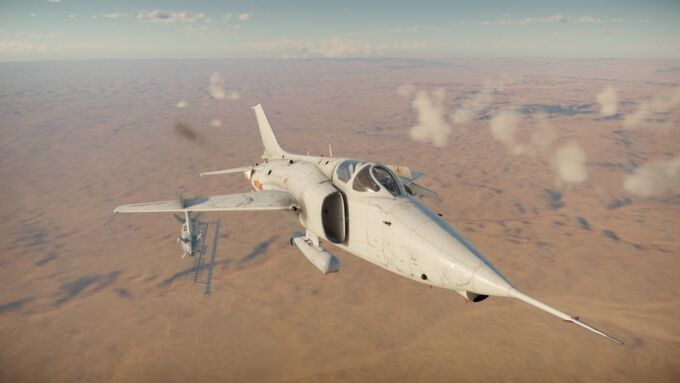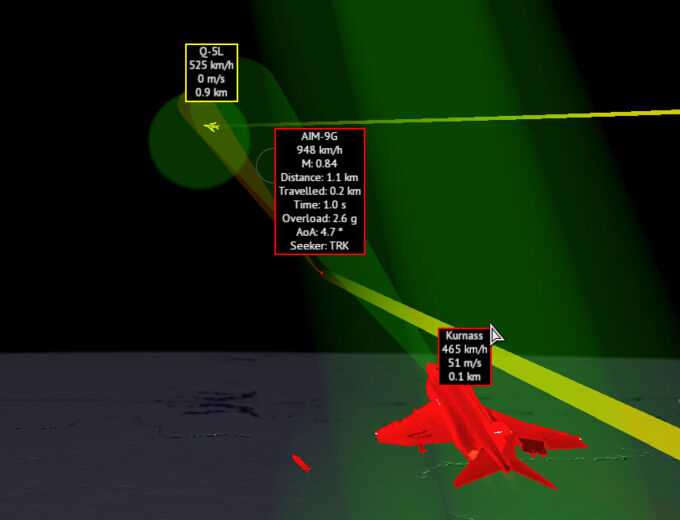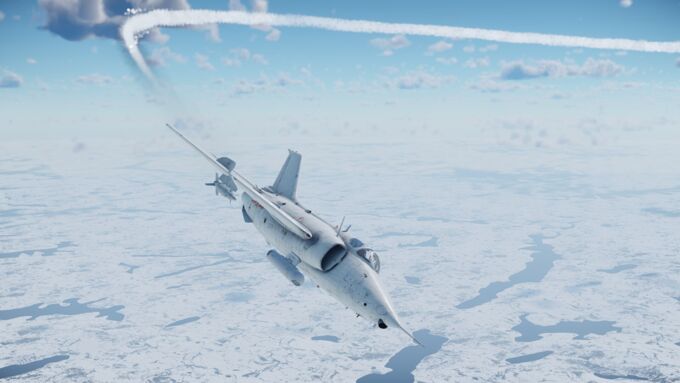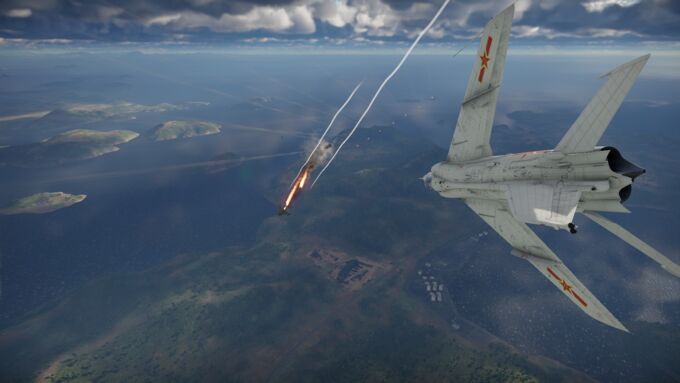The Q-5L is a comprehensive technological modernization of an airframe from a comparably prehistoric era where MiG-19s and F-100s roamed the skies, fitting into a niche virtually unheard of in War Thunder.
| Pros | Cons |
| Extremely high engine thrust and climb rate | Zero air-to-air missiles |
| Targeting pod with thermal optics and decent zoom | Very small amount of countermeasures |
| Has 2 laser-guided bombs | Subpar cannon armament |
| Can out-climb/out-range most SAMs at its battle rating | Suffers from severe control-compression at higher speeds, often necessitating frequent usage of the airbrake in dogfights |
| Excellent RWR for detection of possible threats | Extremely poor dogfighter |
| Decent at energy-fighting | Engines take a rather long time to warm up to maximum thrust on afterburner |
An armament oddity
The Q-5L is an oddball in terms of its weapons, having no form of missile armament whatsoever. In addition to this, the Type-23 cannons found on the Q-5L are painfully frustrating to use due to their low muzzle velocity, making targets difficult to hit at best and nearly impossible to hit at worst.
Despite the Q-5L having some dumb ordnance such as rockets and unguided bombs, taking them is not recommended as the Q-5L is an extremely poor frontline CAS aircraft, and its laser-guided bombs fit its intended niche much better.
The Q-5L carries a maximum of two laser-guided bombs, either the 250 kg GB250 with inertial guidance or the 500 kg GB500, presenting a tradeoff between accuracy and damage. However, due to only carrying a maximum of 1000 kg of guided ordnance, the Q-5L can make the absolute best of its superb flight performance and benefits from a reduced spawn-point cost from only bringing two guided bombs as opposed to a full set of unguided ordnance. The Q-5L uses the K/PSZ01 targeting pod for its guided ordnance, a relatively modern laser-targeting system with decent zoom of 23x and generation-1 thermals.
The lack of air-to-air missiles and its subpar cannon armament does leave it unable to fight back effectively against most airborne threats, but the Q-5L was never designed for such a role in the first place. It is important to note, however, that its highly advanced KJ8602 RWR provides very good situational awareness against most threats along with a limited amount of countermeasures, so while it can’t fight back particularly well, it is not left completely defenseless against enemy attacks.
Flight performance with an unheard niche
The Q-5L’s MiG-19-derived airframe provides it with one key advantage subsonic attackers like the A-10 “Warthog” and Su-25 “Grach” do not: climb rate and raw engine thrust, giving it a unique position as one of the only CAS aircraft at its BR with precision-guided ordnance that can potentially climb out of the range of SAM batteries. The surprising combination of precision-guided ordnance and high climb rate of the Q-5L give it the ability to perform so-called “Orbital Strikes” at a BR where most SAMs are rather short-range. Dropping laser-guided bombs from extremely high altitude while remaining completely untouched by SAMs as their missiles explode harmlessly below you, giving it a relatively unheard-of niche in War Thunder as a superb Wild Weasel/SEAD aircraft or precision strike aircraft tasked with eliminating SAM sites to clear the way for friendly conventional CAS aircraft like the A-10 and Su-25 or eliminating high-priority targets to alleviate pressure on your team.
Some other very important things to note about the Q-5L’s flight performance:
- The Q-5L, like its older variants, suffers from severe control compression at high speeds which necessitates usage of the airbrake to control airspeed sufficiently.
- The Q-5L’s engines, despite having extremely high overall thrust, take a very long time to spool up to full afterburner, which can be a problem when needing to quickly out-climb or evade an enemy aircraft or missile.
- Diving without engaging the airbrake or cutting throttle is an almost-guaranteed way to nose-dive straight into the ground due to the combination of lethargic but powerful engines and control compression.
Survivability
The Q-5L’s MiG-19 airframe displays surprising amounts of survivability, being able to fly with one engine or losing part of a wing due to its extremely high engine thrust. Landing is also relatively risk-free due to the high deployment speed of the drogue chute making runway overshoots unlikely. The Q-5L has a very low amount of countermeasures for a strike aircraft, and the adage of “prevention is better than cure” is very relevant as the Q-5L cannot afford to waste countermeasures recklessly; as such, avoiding an active enemy threat and staying out of sight is better than flying right in front of a missile-carrying aircraft or SAM system and risking a missile to the face.
Strategy in Ground Battles
When you first spawn in, immediately begin side climbing away from the battlefield to about 6-7 kilometers altitude or higher to set up for an initial attack run, highlight your target with your targeting pod, then drop your first bomb, wait for it to either hit or miss its target and then circle around for another run, or return to base for another load of bombs. It is a very simple strategy, make no mistake, but is highly effective when done properly.
Climbing to high altitude is the most fundamentally preventative measure one can take to avoid getting shot down by enemy SAMs or aircraft, playing to the Q-5L’s strength. Many ground-based search radars do not have the vertical scanning capability to reach particularly high up, and their missiles cannot usually reach you at that range; furthermore, enemy fighters will need to climb to you while you hold a significant energy advantage and can easily outrun or energy-trap any threat.
Once set up for an attack run, identify your target and lock it with the IRST Auto-tracker of your targeting pod. Do not enter a steep dive on the target as this can put you in range of enemy SAMs and could cause a swift nose-dive into the ground due to the severe control compression at high speed.
Drop your LGB and wait for a hit on your target. Don’t take evasive action or circle around for another attack run until your LGB has hit the ground unless you’re suddenly pinged by a missile launch on your RWR or if you see an enemy aircraft coming straight for you. The age-old adage of “prevention is better than cure” is extremely true in the Q-5L’s case; the Q-5L possesses qualities that make it nearly defenseless in dogfighting scenarios or trying to evade missiles via maneuvering, such as a complete lack of air-to-air missiles, lackluster cannon armament, and extremely severe control compression at high speeds. But as a MiG-19 derived aircraft, it is a superb energy-fighter. Given this information, the best option is to immediately begin zoom-climbing to higher altitudes or prepare to return to base if you’re caught in an inconvenient position and pop countermeasures sparingly if you’re fired at with a heat-seeking missile.
Strategy in air battles
The Q-5L, while not as well-suited for air battles compared to other aircraft, still reigns supreme in the field of energy-fighting due to its extremely high climb rate and MiG-19-derived airframe. However, one must be extremely mindful of the very low amount of countermeasures given and avoid diving headfirst at enemies as control compression will spell doom for any attempt to pull up from a dive.
When taking off from the airfield, immediately begin climbing to around 3000 feet; it is generally recommended to try and take bombs for ground-pounding as attempting to dogfight is generally not advised with the lack of air-to-air munitions. However, if you still wish to dogfight, you should prioritize aircraft with slow climb rates or weak engines such as the F-5C, these aircraft have a tendency to become very sluggish below approximately 800 km/h or so. This trait combined with their very weak engines plays exactly to the Q-5L’s strengths with excellent engine power and acceleration, allowing you to go in for a kill against a much stronger opponent.





